New management at G.-Henle-Verlag
Norbert Gertsch succeeds Wolf-Dieter Seiffert at Münchner Urtext-Verlag.
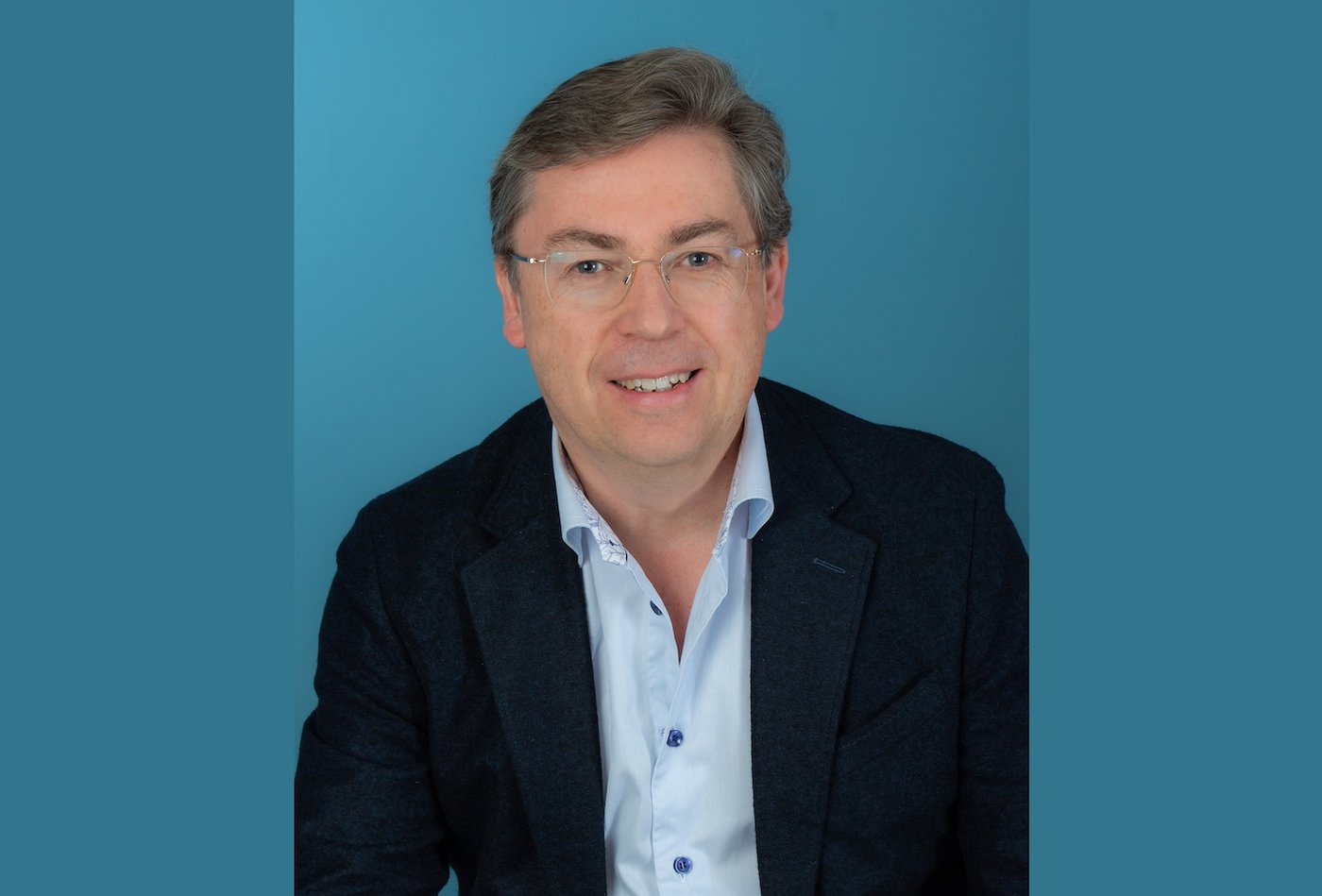
Norbert Gertsch succeeds Wolf-Dieter Seiffert at Münchner Urtext-Verlag.

Francesco Raselli himself has his say in this new publication, but above all friends, fellow musicians and experts shed light on the life and work of the early deceased.
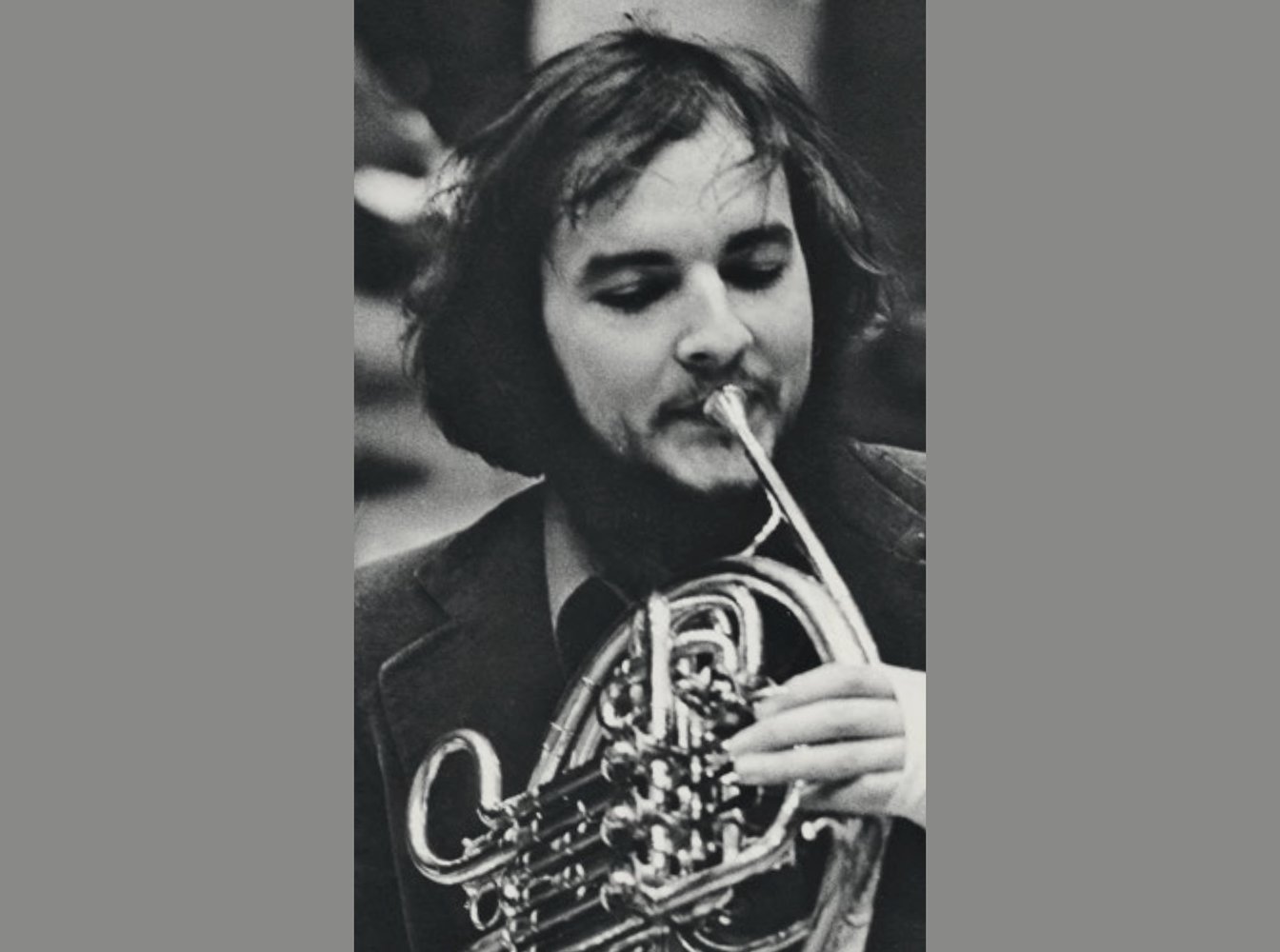
Exactly 40 years ago, the Obwalden horn player, organist, composer, teacher and mediator Francesco Raselli, who had his roots in the Poschiavo village of Le Prese, died at the age of 35. His reputation still resonates today. So, on the initiative of the three editors and co-authors Josef Gnos, Niccolò Raselli and Peter Bucher, companions, friends, experts and those born after him have delved into Raselli's life and work and rummaged through their memories. The result is a book that illuminates all facets of this exceptional artist and his orchestral engagements (General Music Society Lucerne, Festival Orchestra of the Lucerne International Music Festival, Stuttgart Radio Symphony Orchestra, Basel Radio Symphony Orchestra).
Raselli was not above leaving his mark in brass and folk music, for example as a section leader and soloist in the Feldmusik Sarnen, one of the most powerful brass orchestras in Central Switzerland. As a teacher, he taught at the Sarnen Music School and soon also as a main subject teacher at the Lucerne Conservatory, but always remained connected to the canton of Obwalden. His pupil Walter Dillier quotes him with the bon mot: "Only the first horn player is allowed to play, not the second." In addition to Raselli himself, the book also features the musical personalities Mario Venzago, Thüring Bräm, Lukas Christinat, Jakob Hefti and Wolfgang Sieber, among many others.
Raselli composed around forty works in fifteen years, including around a third for the legendary Nyynermuisig instrumentation he invented. In his extensive and meticulous analysis, Roman Brotbeck deals in detail with the twelve-tone conception of the Septet from 1974, the brass quintet from 1982, the undated Solo for A clarinet and finally with Raselli's legacy, the Diary for 16 clarinets and double bass from the year of his death in 1983. The book is supplemented by specialist texts, facsimiles of sheet music, caricatures and recipes by Raselli, numerous photos from his life and work as well as watercolors and drawings by Josef Gnos and his daughter Anna Raselli.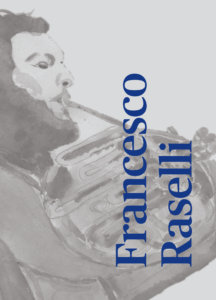
Francesco Raselli 1948-1983, ed. by Josef Gnos, Niccolò Raselli and Peter Bucher, 208 p., Fr. 40.00, self-published by the editors, 2023, ISBN 978-3-033-10003-9, source of supply: Vreny Guardiano, Lindenstrasse 14, 6060 Sarnen, vreny.guardiano@bluewin.ch
In Anna Reichert's booklet "Play with us!", animal helpers accompany children as they try out and vary pianistic movements.

Perhaps the author Anna Reichert has taken Manfred Spitzer's words to heart: "A good teacher will tell stories ... Stories drive us, not facts." Starting with each key of the root scale, this booklet develops "finger exercises" that stimulate basic pianistic playing movements. Key C, for example, is inspired by Coco, the high-spirited chimpanzee who loves to swing from tree to tree. Coco swings from branch to branch using tied groups of two notes, addressing themes such as weight and relaxation and the slight withdrawal of the hand after the second note.
In an accompanying text, the author explains the technical objectives of each exercise and points out further ideas for playing. In the foreword, she encourages children to be imaginative with the examples and to find their own variations together with the children: explore different sounds by transposing, include black keys, break up the rigid five-finger position as often as possible, move freely across the entire keyboard and vary the distances between the fingers. All of this is intended to enrich the learning process on various levels. For this reason, the basic structure of the individual exercises has been simplified as a guide for parents and teachers.
I like the simplicity and at the same time the versatility of the system, which is able to stimulate the imagination of both learners and teachers.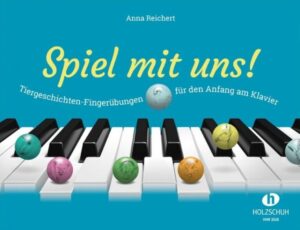
Anna Reichert: Play with us! Animal story finger exercises for beginners at the piano, VHR 3518, € 11.80, Holzschuh, Manching
Jury Clormann has arranged the "Ständchen" and some dances for two guitars.

"Quietly my songs plead / Through the night to you..." - the setting of Ludwig Rellstab's Serenade by Franz Schubert in the posthumously published song collection Swan song has inspired many other composers and editors to make instrumental arrangements. The version for two guitars, as now presented to us by Winterthur guitarist Jury Clormann, is also musically rich and also easy to play on the twelve strings.
The piece was part of the repertoire of Clormann and his duo partner Elisabeth Trechslin and can be listened to on Youtube be. Clormann cleverly based his arrangement not only on Schubert's original, but also on the piano version by Franz Liszt and the solo guitar version by Johann Kaspar Mertz. He adopted Liszt's small-scale fugal triplet motifs, but borrowed from Mertz in the final section with its various arpeggios. What Mertz had omitted from Schubert's musical material was added to by Clormann. All of this in the service of the romantic intimacy of Schubert's music and Rellstab's lyric: "Let your chest move too, (...) Come, make me happy!"
The sheet music edition also contains the arrangements of three short piano pieces: Minuet and Trio, a Waltz (the first of 36 original dances from op. 9 and D. 365) and a German dance and Ecossaise - all exemplary edited, with score and individual parts, but without fingerings.
Franz Schubert: Serenade, Minuet, Waltz, German Dance and Ecossaise, edited and published by Jury Clormann, first edition, BP 2883, Fr. 19.50, Amadeus, Winterthur
Johannes Schild explains in his book that the symphonies of the "progressive" Brahms also carry hidden messages and meanings.
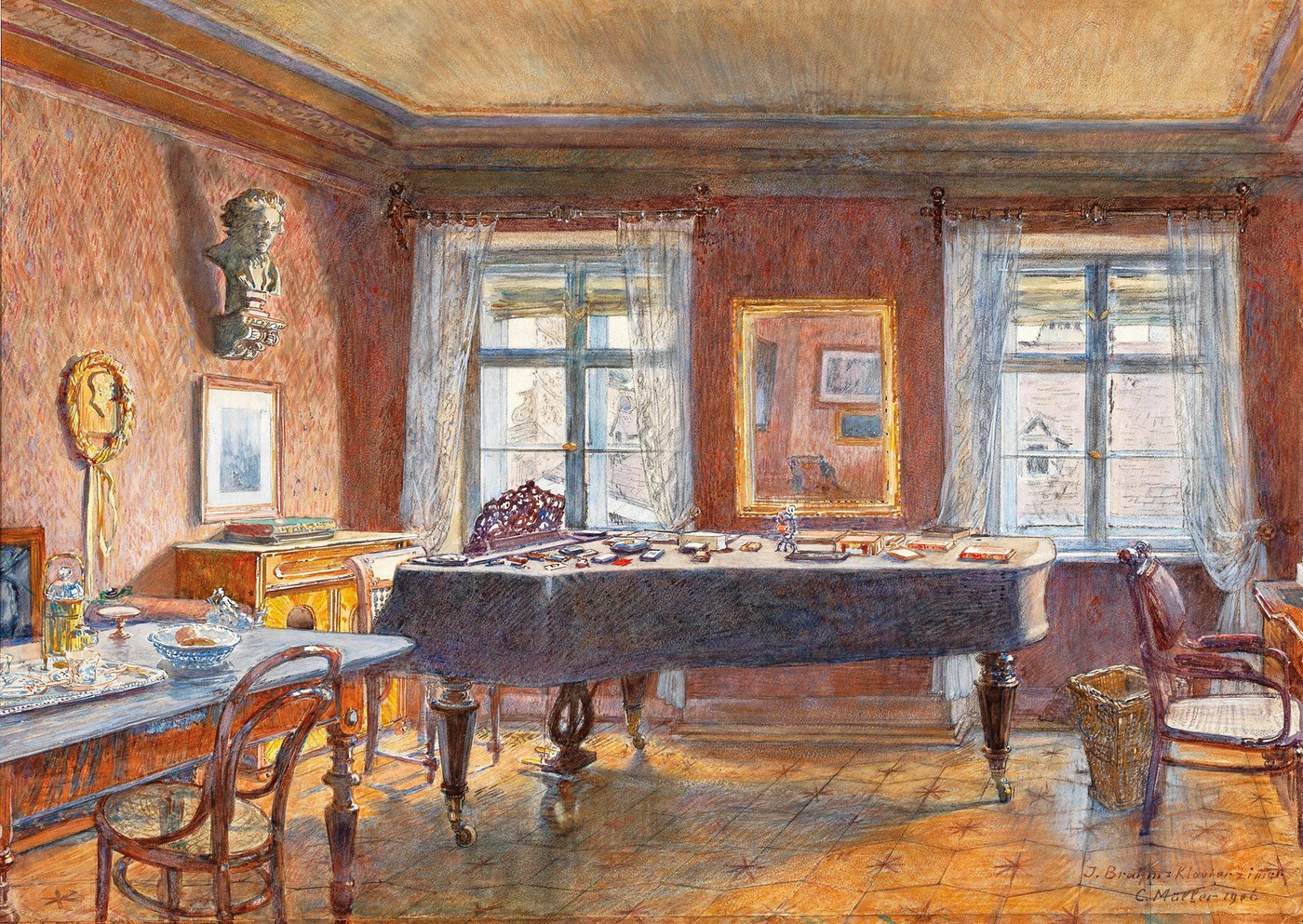
If the quote in the title of this book had reminded you of Gustav Mahler, you would have been wrong, but you would have expected hidden messages from Brahms. Arnold Schönberg had placed him at the forefront of modernism at the time as the "progressive" precisely because his compositions corresponded to Hanslick's "tonally moving form" and took a back seat to the "symphonic poems" of Liszt and Strauss, which were saturated with literature.
Schönberg would be amazed today if he were to pick up Johannes Schild's book, in which the author discovers many hidden messages in Brahms' four symphonies that establish connections to Bach, Mozart, Beethoven, Wagner, Liszt and others. The fact that not only Mahler, but also Brahms, used the linguistic capacity of music to come to terms with himself and his work is astonishing with each new case, which Schild is able to explain in a stylistically confident and comprehensible manner, and not only for those readers who are able to evaluate the many musical examples accordingly.
The cross-movement relationships in the symphonies are interesting in themselves, but even more rewarding are the cross-movement relationships and those that establish connections across musical epochs. Starting with Bach's E major fugue, the final theme of Mozart's Jupiter Symphony a whole range of covers right up to the Song of Destiny.
Particularly astonishing in another context are the Meistersinger-Aspects that Tristanor the musical references to the "milk-young boy" Felix, who could at best be the illegitimate son of Johannes Brahms resulting from his intimate relationship with Clara Schumann.
With three hundred musical examples, sixty pages of notes and twenty-four pages of bibliography, the book underpins the surprising wealth of compositional "innards", but also extra-musical influences, which one would not have expected from Brahms in particular.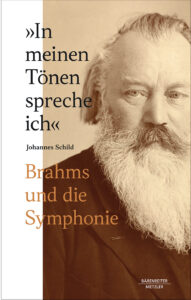
Johannes Schild: "In meinen Tönen spreche ich" - Brahms und die Symphonie, 443 p., € 49.99, Bärenreiter/Metzler, Kassel/Stuttgart 2022, ISBN 978-3-7618-2525-9
How does composing work today? 33 musicians express their views in the volume "musik machen".
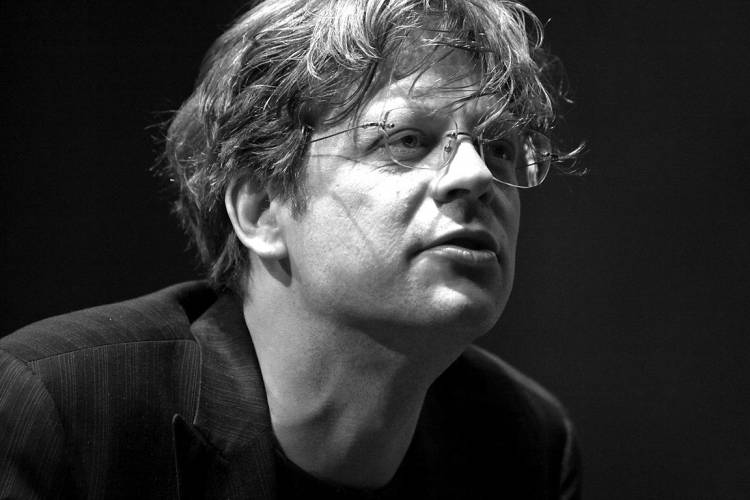
The word "composing" has many connotations: creativity, of course, but also the struggle for ideas, thinking up new sounds or new constellations. It is therefore remarkable that Basel-based composer Wolfgang Heiniger believes that music cannot be "reinvented". In his opinion, the meaning of composition is already in the word: "You put things together," he says.
The volume published by Vexer-Verlag make music with one- to three-page statements by 33 contemporary composers is as entertaining as it is inspiring. New music can hardly be reduced to a common denominator. And this also applies to the printed texts, which revolve around aesthetics in general, personal working habits or creative processes. Some of them are reminiscent of older composer images. Dieter Ammann writes: "Composing actually means being a seeker in a world whose creator you are at the same time." Ammann's search can sometimes take time. Sometimes he thinks about a work for three years. Yes, perhaps Beethoven's furrowed brow comes to mind.
Ammann's tone is refreshingly direct, and this also applies to his colleagues. Isabel Klaus makes a virtue out of necessity. She needs resistance, sees the usual commissions - "write a piece for this or that cast with this or that duration" - not as a restriction on her creativity, but as an opportunity to creatively rub up against "stones that are put in her way".
Most of the composers selected and interviewed by the editors Désirée Meiser, Matthias Schmidt and Anja Wernicke come from the Basel area. Some big names broaden the regional perspective: Wolfgang Rihm, for example, the German Mathias Spahlinger or the Dane Simon Steen-Andersen, who has been very successful in recent years. The latter mentions his "negative inspiration": when he hears "great music", he thinks that he has to make an effort to "do it completely differently".
Ultimately, composing today is also very different. Earlier ideas of a god-like creatio-ex-nihilo genius, who intimidatingly and authoritatively puts his brilliant sparks on paper, are fortunately a thing of the past. Today, as the anthology impressively demonstrates, it is much more about cooperation with musicians, about influences, sometimes also about down-to-earth work that has to be done. Johannes Kreidler, Professor of Composition at the Basel University of Music, sums it up nicely: "Ideas don't come out of the blue. The beginner waits for the kiss of music, the professional starts to work."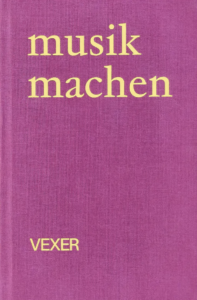
musik machen, ed. by Désirée Meiser, Matthias Schmidt, Anja Wernicke, 144 p., Fr. 28.00, Vexer, St. Gallen 2023, ISBN 978-3-907112-63-2
The songs by Eugen Meier on texts in Valais German by Hannes Taugwalder alternate here with songs in High German by Swiss composers.
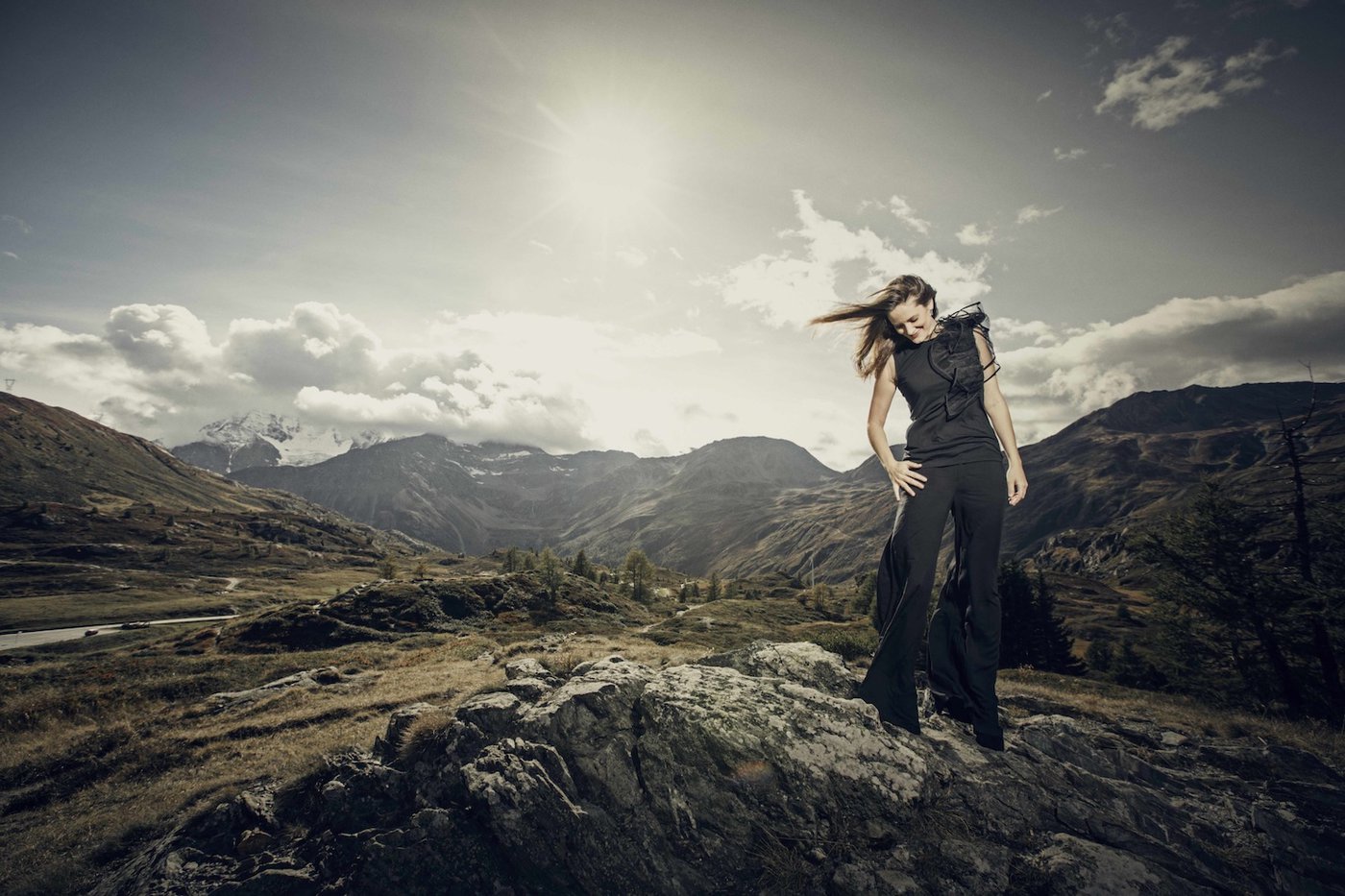
When the Aargau pianist Werner Schmid, together with the soprano Christina Lang and the mezzo-soprano Margrita Sarbach, recorded the pioneering CD And 's Meiteli sings mostly unknown children's and dialect songs by Swiss composers, samples stood out from the booklet Songs from around the valley by Eugen Meier because of their distinctive Valais dialect.
The soprano Franziska Heinzen and the pianist Benjamin Mead have now recorded all but two of the 16 songs based on texts by the writer and industrialist Hannes Taugwalder (1910-2007), who grew up in Zermatt, for the first time. Compared to the first edition from 1981, some of them have been expanded with pianistic introductions and postludes.
Born in Aargau in 1934 and trained in Vienna by Julius Patzak and Hans Swarowsky, the composer, conductor and teacher Eugen Meier has lived and worked in Valais, which has become his second home, since 1961. His works, which deal with longing, love and closeness to nature Songs from around the valley are heard on this cleverly conceived CD with the subtitle "An Homage to Swiss Art Song", alternating with carefully selected, thematically related songs on German-language texts by Hesse, Lenau, C. F. Meyer, Morgenstern and Storm, among others. Settings by well-known composers such as Joachim Raff, Othmar Schoeck, Frank Martin and Heinz Holliger alternate with contemporary contributions by Isabel Mundry and Werner Bärtschi on the one hand, and songs by long-forgotten composers such as Walter Courvoisier, Emil Frey and Hermann von Glenck on the other.
Originally from the canton of Valais, Franziska Heinzen guarantees an authentic rendition of the text. Songs from around the valleywhich she sings with a folk-song-like simplicity of tone. In the mostly late-romantic art songs, she drifts into the operatic with a strong vibrato, especially in the high registers. This is in contrast to Hans Huber, for example, who in the Girl's song op. 61 No. 3 "flattering, with the most delicate expression". Discreetly supported on the piano by Benjamin Mead, the singer gives the impression that she has to break out of the reservation of rustic Valais music in order to win over an urban audience with a more expressive style of singing.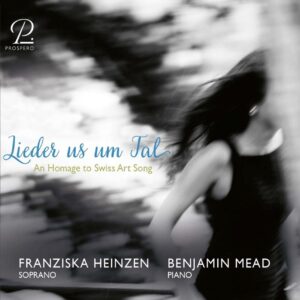
Songs from around the valley. Franziska Heinzen, soprano, Benjamin Mead, piano. Prospero PROSP 0062
The piano piece "Vertigo" by Philipp Manuel Gutmann creates a dramatic event in a short space of time.

Vertigo - who doesn't think of Alfred Hitchcock's psychological thriller when they hear this word? A movie that revolves around a policeman (James Stewart) who suffers from a fear of heights after a traumatic experience. A movie, by the way, in which Bernard Herrmann's congenial music plays a central role. The young Austrian composer Philipp Manuel Gutmann has now also prefixed one of his latest works with the name "Vertigo" and subtitled it "Bagatelle for piano". In June 2021, he won the Audience Award of the 1st Days of New Piano Music Graz.
Philipp Manuel Gutmann was born in Zwettl (Lower Austria) in 1993. He studied composition in Vienna (with Dirk D'Ase) and in Zurich (with Kaspar Ewald and Isabel Mundry). Despite his young age, he can already boast a considerable oeuvre. It includes stage works and symphonies as well as chamber music and numerous works for choir. And he seems to have a particular soft spot for wind orchestras.
Back to his piano piece Vertigowhich actually refers to Hitchcock's film. It begins "slowly and menacingly" with repetitive figures that gradually increase in tempo and volume. These are joined by melodic fragments that obviously quote motifs from Bernard Herrmann's film music. Chords are alternately broken up and down. On the last page, the calm beginning finally turns into an impetuous chase. The resulting effect really does create a feeling of disorientation, of dizziness.
Pianistic is Vertigo not as tricky as it might seem at first glance. The piano writing is excellent. (The only fingering indication at the very beginning should probably be 3213). In any case, it is not surprising that the audience in Graz was taken with the work, as Gutmann manages to immediately conjure up a dramatic and vivid scene in just a few pages using modern means.
And those who are still unfamiliar with this music should perhaps take another look at Hitchcock's masterpiece ...
Philipp Manuel Gutmann: Vertigo, Bagatelle for piano, D 01 450, € 12.95, Doblinger, Vienna
"Cocoon" by Annakin is a collection of delicately transparent songs in which the piano plays an important role.

The eighth solo album by Annakin - once the voice of the Baden-based trip-hop combo Swandive - begins with one of the most beautiful songs she has recorded during her long career. It is called Marian and is something like a sounding program booklet. She wrote the song when the attack on Mariupol began, the artist explains. Later, she realized that it summed up the theme of the whole album. "It's about protection and war and, above all, about catharsis. It's about an experience that you have to process in order to find your way to creativity and create something new."
After the frustration of the lockdown, which had ruined all kinds of plans, she went into a veritable creative frenzy, which culminated in her trip to La Frette Studio near Paris - an elegantly dilapidated villa where Nick Cave, Marie-Joe Thério and Marianne Faithfull have also created sonic delicacies. This studio was chosen not least because it was equipped with instruments that met the artist's sonic expectations: a Bösendorfer piano, for example, which sounds as if it were wrapped in a absorbent cotton cocoon (ha!), a massive Oberheim synthesizer and a Neve mixing console. As with their last album, the recordings were made under the aegis of British producer Ed Harcourt, who can look back on a series of noble, idiosyncratic albums as a singing songwriter. According to Annakin, it is thanks to him that the album is less electronic and more piano-heavy.
The title Cocoon not only sums up the mood in terms of the theme, it also metaphorically describes the effect of these gauze-like, transparent songs. They need time to draw the listener in, but the threads are strong ... Another fine chapter in the story of a tireless, quiet adventurer.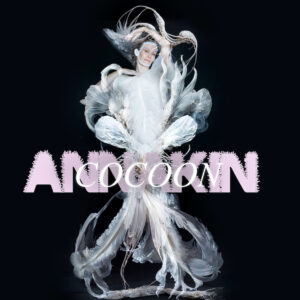
Annakin: Cocoon, Phonag Records, annakin.net
Basic knowledge of classical music, served up with lots of drawings and humor.
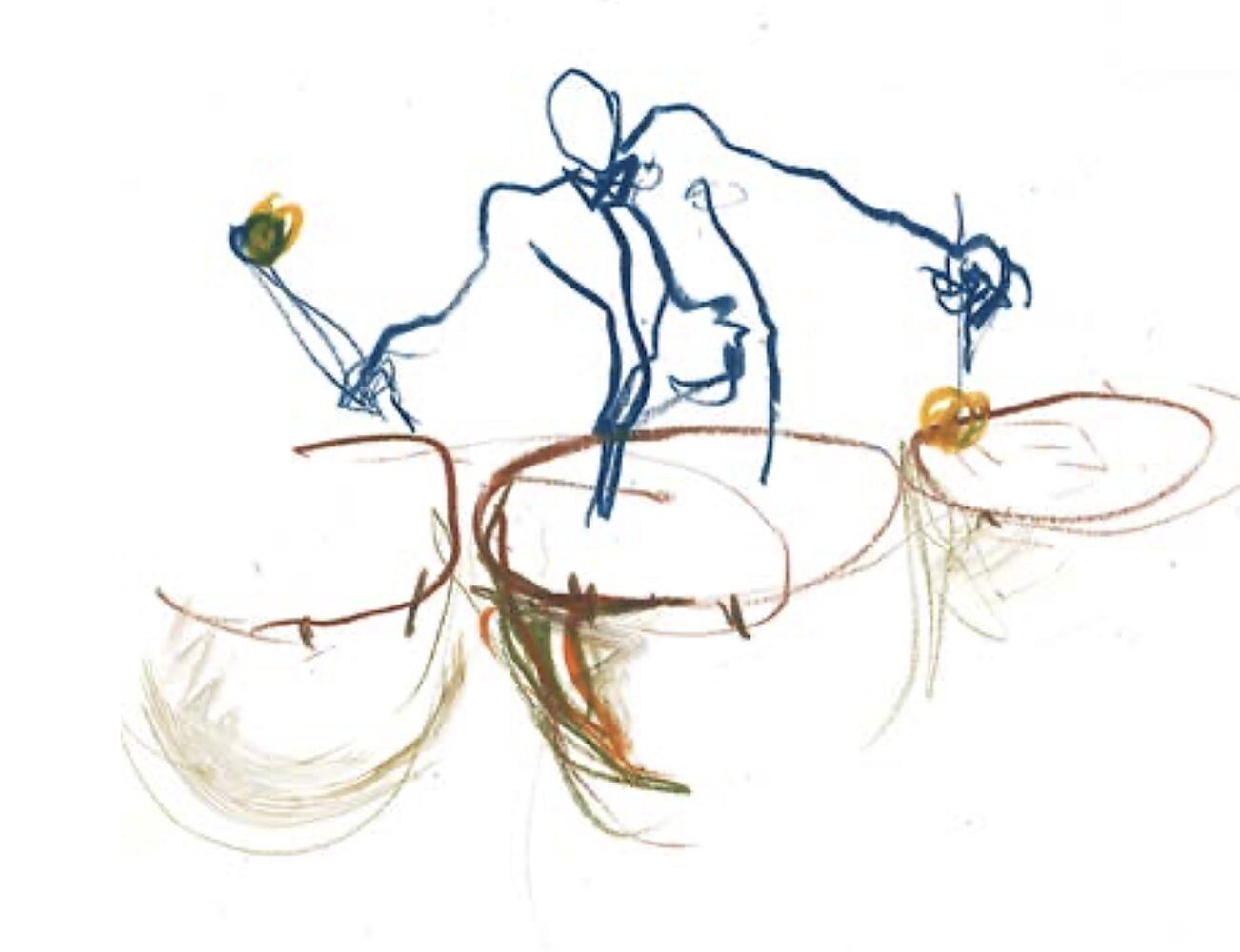
The author, who has directed choirs in Schaffhausen and works as a concert reviewer, wants to bring people closer to classical music with this colorful little book. The musical terms listed, from "absolute pitch" to "magic", are spiced up with humorous comments, 14 special composers from Hildegard von Bingen to John Cage are given a special page, 350 are listed with their life dates and musical style and the orchestral instruments are drawn and named.
On every other page, Linda Grädel's lively drawings depict the dedication of musicians. Helpful and inspiring for young music students and concertgoers.
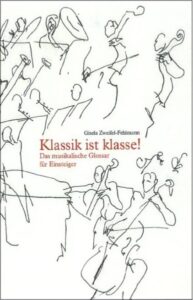 Gisela Zweifel-Fehlmann: Classical music is great! The musical glossary including a list of composers for beginners, with drawings by Linda Grädel, 160 p., Fr. 10.00, Edition ABCDEF..., Diessenhofen 2023, ISBN 978-3-03858-732-3 (print)
Gisela Zweifel-Fehlmann: Classical music is great! The musical glossary including a list of composers for beginners, with drawings by Linda Grädel, 160 p., Fr. 10.00, Edition ABCDEF..., Diessenhofen 2023, ISBN 978-3-03858-732-3 (print)
Howard Griffiths was artistic director of the Orpheum Foundation for 23 years. Now the pianist Oliver Schnyder is taking over this role. A review and outlook
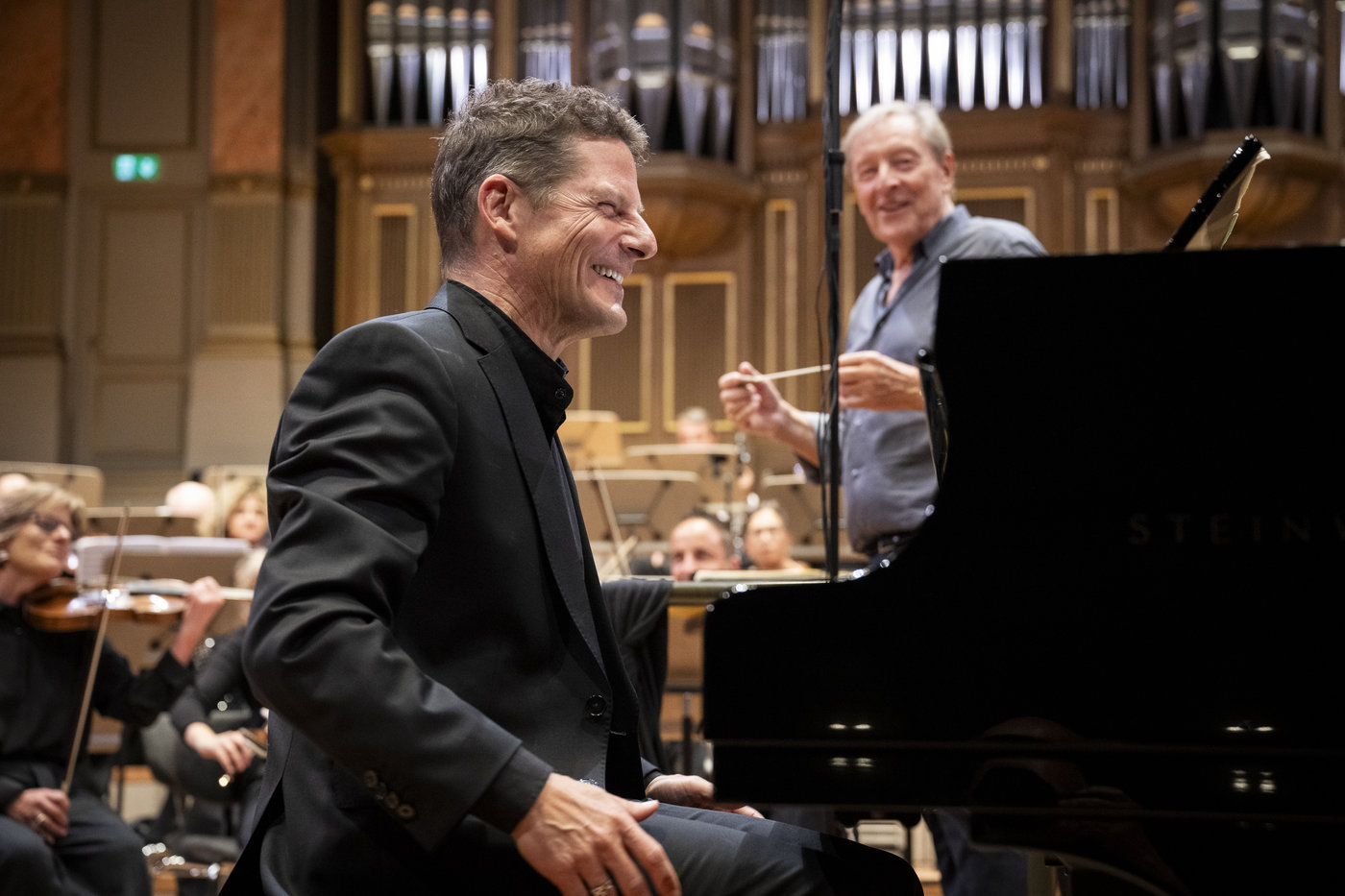
The reason why he will be missed was also evident when he left. For over 30 years, the Orpheum Foundation young musicians. At the concert on October 21, which also marked the handover of artistic direction, Howard Griffiths demonstrated in a short farewell speech what it takes for a successful artistic career in addition to talent. He described his Orpheum Supporters Orchestra as a "doctors' orchestra", a term that in no way sounded disrespectful coming from him, but only underlined the mischievousness and enthusiasm of his personality.
Personality is also the main criterion he looks for as a "talent scout" in addition to musical qualities, Griffiths emphasized in the previous telephone conversation. In recent years, the number of technically highly talented people has increased, but the "very special artistic personalities" remain as rare as ever. An assessment shared by his successor Oliver Schnyder. In a written interview, he emphasized that the interpretations of young artists are increasingly approaching a "widely accepted standard" due to the lack of time for organic development, and concludes with the remarkable sentence: "I'm not at all sure whether musical personalities such as Fritz Kreisler, Edwin Fischer, Clara Haskil or Pablo Casals would still assert themselves in a comparable way today."
So the two are in agreement on the matter. The Orpheum Foundation is all about picking out unique personalities from the large reservoir of talent. A task that has been successfully accomplished so far, as a glance at the archive shows: Truls Mørk, Renaud and Gautier Capuçon, Yuja Wang, Alisa Weilerstein, Nikolaj Znaider, to name but a few, have all benefited from the foundation's support. It is therefore fair to speak of a success story. And all the indications are that this will continue with Schnyder. Schnyder, who was once one of the "pupils" himself, sees himself first and foremost as a new member of a strong team. Continuity is therefore the magic word, only the setting of a few new priorities is to be expected.
In terms of this new focus, the concert on October 21 can also be described as programmatic. The Danish-Ukrainian violinist Anna Agafia Egholm, born in 1996, did not appear as the all-conquering soloist, but played Beethoven's Triple Concerto together with the former Orpheum soloist Maximilian Hornung on cello and Oliver Schnyder on piano. The concert thus pointed the way forward: the purpose and funding model of the Orpheum Foundation is to bring young soloists together with well-known orchestras and conductors. "We will now also transfer this idea to chamber music and invite great mentors to rehearse and perform with the young musicians," says Schnyder, describing his vision for the future.
For this reason, it did not matter that no "top orchestra" played the evening. Even though the Orpheum Supporters Orchestra, made up of amateurs and a few professionals, did a good job, it is not an ensemble in the sense of the foundation's guidelines. The interplay with the two established soloists, on the other hand, was definitely a top performance. The comparison with Hornung in particular also revealed Egholm's potential for development. His more concise and vivid phrasing impressively demonstrated what can be achieved in the often misunderstood Triple Concerto.
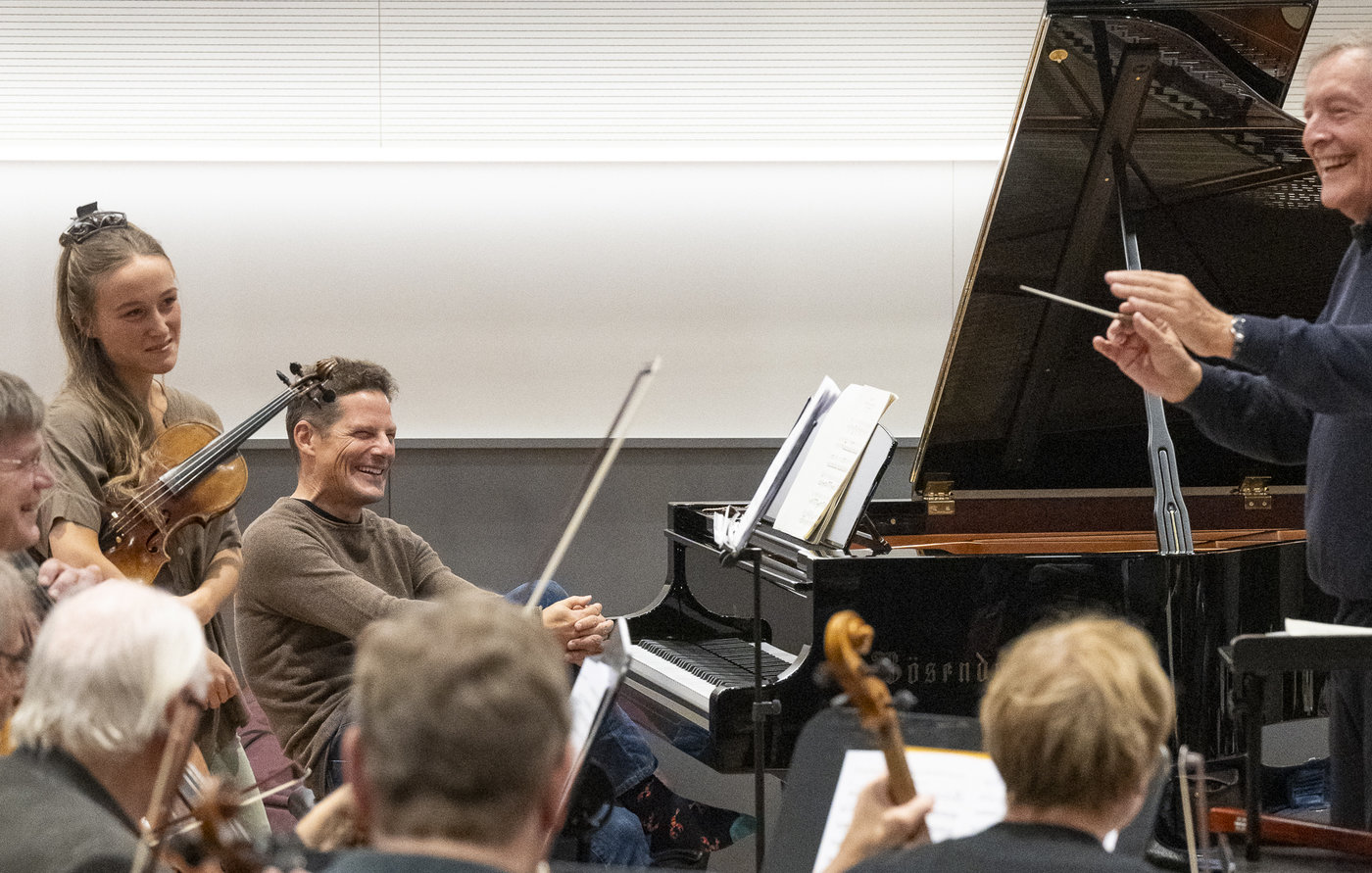
Speaking of development potential: despite all the praise for the Orpheum Foundation's track record, it could also exploit some new opportunities. Not from the point of view of those who are satisfied with the status quo of the classical concert business: Famous performers play the well-known repertoire from the 18th and 19th centuries. For everyone else, however, it would be nice if the 800-year tradition of classical music, which is constantly being developed further, were also more strongly reflected in the promotion of young talent.
Howard Griffiths has tried to do this with the introduction of Composers in Residence, among other things, but cited the enormous effort involved, which a small foundation could hardly cope with organizationally. Oliver Schnyder explicitly referred to the foundation's purpose in this regard, but did not rule out a certain expansion of the repertoire due to the new chamber music formats. And yes, it is not the task of a single foundation to reform the classical music business. But is it presumptuous to place a little hope in a foundation that established a revolutionary funding concept just over 30 years ago?
On November 9, a forum launched by the Aargau Cultural Association and the Pro Argovia Cultural Foundation took place in Baden. The presentations and panel discussions revolved around the topic "Culture is systemically relevant!".
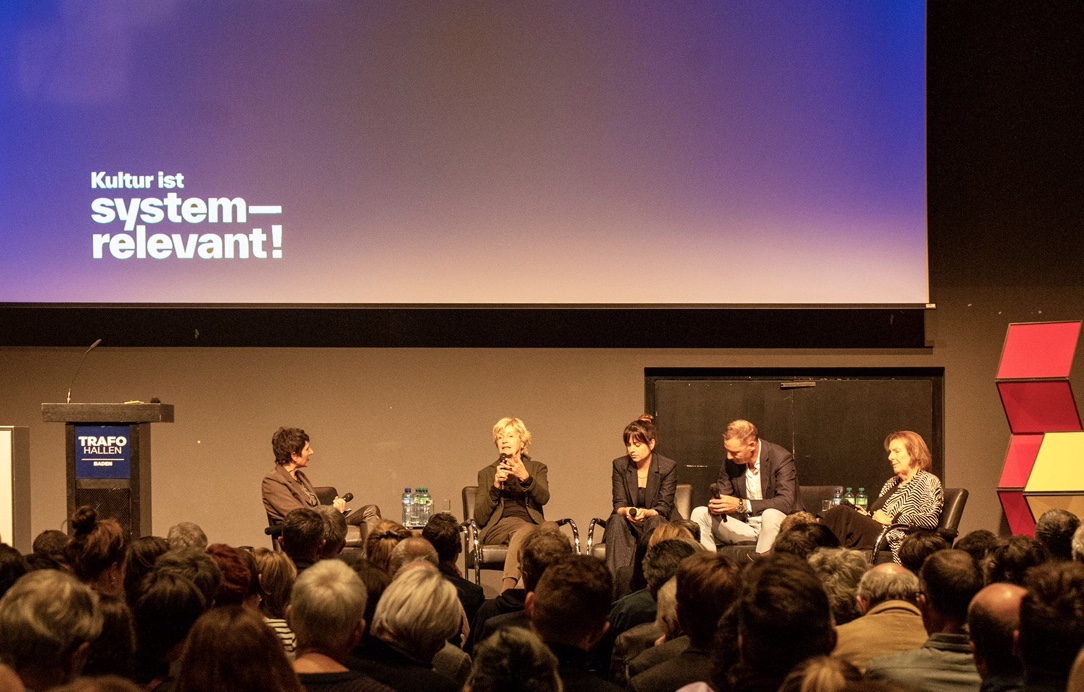
The Aargau Cultural Association is relatively new. In November 2019, various cultural institutions and freelancers from the canton of Aargau joined forces. The dedicated board covers various sectors and has set itself the goal of making Aargau's cultural activities more visible and, above all, to make a name for them in political circles. one voice to lobby for culture. A new managing director, Daniel Hertli, has just been elected.
Under its first managing director, Michael Schneider, the association not only took a clear stance on decisions made by the Grand Council and on the Aargau Culture Concept 2023-2028, but also worked to better inform members of the Grand Council about the difficult framework conditions for culture. Thanks to Grand Councillor Markus Lang, a cultural group has been set up with around 40 members from various parties. Guided tours are organized for this group, allowing them to take a look behind the scenes.
The importance of culture
In his welcoming address at the opening of the forum, Mayor Markus Schneider emphasized that Baden is a self-confident and vibrant cultural city of which he is proud. And cantonal councillor Alex Hürzeler said in conversation with moderator Monika Schärer that culture is important for the cohesion of society and for the attractiveness of a location, especially in these geopolitically difficult times.
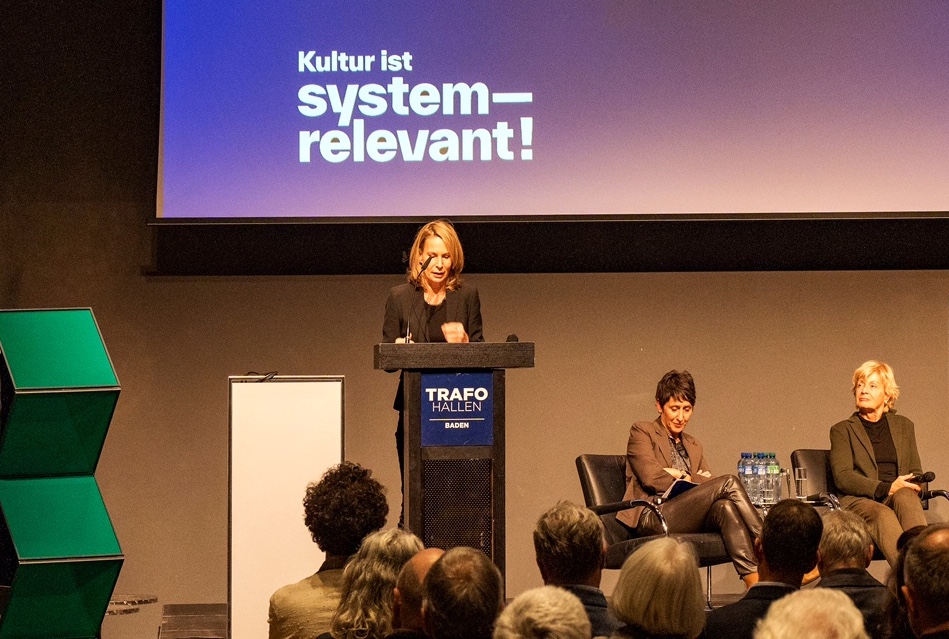
As a political philosopher, Katja Gentinetta reflected on the concept of culture in her opening speech. Culture is the further development of intellectual and moral forces, everything that makes our lives better. In her opinion, culture is no less systemically relevant than agriculture or healthcare. And a good corporate culture may not be measurable, but it is indispensable.
An interesting panel of speakers led a panel discussion after each presentation: for physicist Christian Brönnimann, founder and Chairman of the Board of Directors of Dectris, culture has a lot in common with science. Both areas are associated with a great deal of effort and passion, and money is not the main focus. His company supports culture with a share of its profits. However, this is only possible if the business is successful.
For Maja Wanner, wife of Peter Wanner, Chairman of the Board of Directors of the media company CH-Media, culture is the lubricant of society and a bulwark against brutalization. Getting together, the shared live experience, is becoming increasingly important. She, who is heavily involved in fundraising for culture, sees the growing anonymity of companies as a problem. There is a lack of independent and enthusiastic entrepreneurs who can be approached personally.
For Christine Egerszegi, former member of the Council of States and cultural ambassador, art is not charitable work, but a profession to be taken seriously. One problem in Aargau is that there are very few foundations here. She also argued vehemently that a proportion of every company's profits should be spent on culture. When you consider what the Migros Culture Percentage has achieved to date, you can only agree with Egerszegi.
What values does culture generate? And for whom?
Christoph Weckerle, Director of the Zurich Center for Creative Economies at the ZHdK, put the concept of values into perspective in his presentation by looking at it globally. And Nicola Forster, President of the Schweizerische Gemeinnützige Gesellschaft, emphasized that Switzerland, with its four language cultures, is a nation of will. It does not have one It is more the need for origin and homeland than a dominant culture.
Antonina Businger, a young artist who has successfully founded her own limited company, took part in the panel discussion. At this summer's Badenfahrt, she was the youngest festival organizer and artistic director the event has ever had. Original entertainment was also provided at the forum, and the linguistic acrobatics of author Simon Libsig were well received. When Monika Schärer asked whether there were any businesswomen and politicians in the audience, a number of hands went up. Georg Matter, Head of the Culture Division in the Aargau Department of Education, Culture and Sport, was also present and was asked by Schärer at the end about the role of business in promoting culture. He aptly said that this forum was also in a bubble. In his experience, many people have no idea about culture. This makes it all the more important to talk about it publicly and make it more visible. The packed hall made it clear that the Aargau Cultural Association and Forum Pro Argovia had made a start with this event.
In the special exhibition "Grenzenlos lüpfig", the Rhaetian Museum in Chur reveals the diversity of traditional music in this canton and shows how it absorbed influences from other regions and in turn influenced music from abroad.
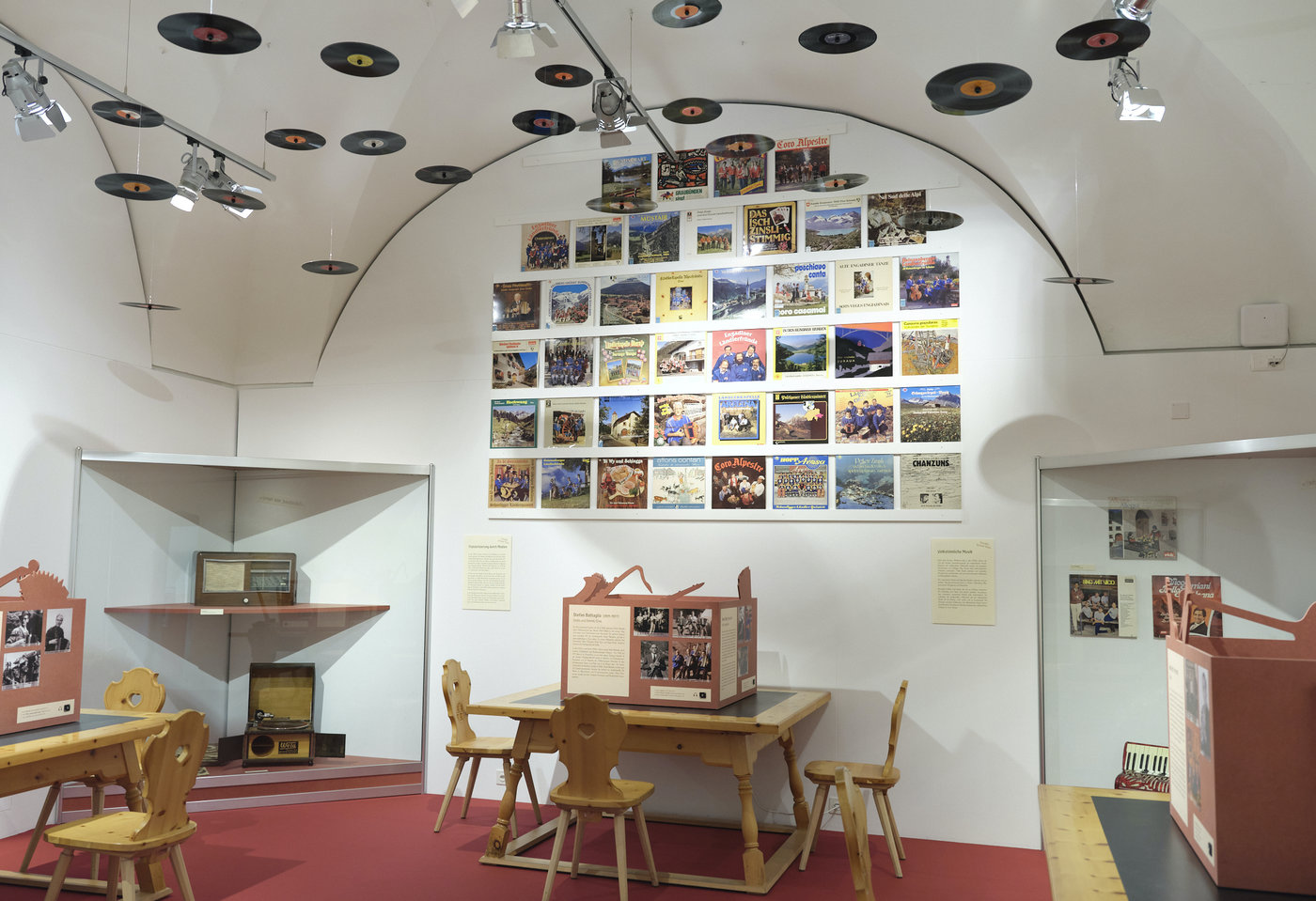
Silvia Conzett and her team have brought together around forty musical instruments from the museum's own collection, several local museums in Graubünden and the recently opened Haus für Instrumente in Kriens and supplemented them with numerous photos and sound samples. For in-depth study, small reference libraries with songbooks, playbooks and secondary literature are also available in each exhibition room.
The important vocal tradition in Graubünden - it is sung in five Romansh idioms, German, Italian and Rumantsch grischun - is presented in pictures, sheet music, audio stations and publications, including editions of the important folk song collection by Alfons Maissen. The life-size silhouettes of a group of seven singers invite visitors to sing along to one of the seven melodies. Instead of a catalog, the exhibition texts are freely available as handouts.
Just like the traditional music of the whole of Switzerland, the folk music of Graubünden corresponds to a locally shaped alpine folk music, which however reflects the influences of the neighboring countries. The southern valleys have the bandella, a small wind band, with Ticino, Lombardy and Piedmont. In the Lower Engadine, the Tyrolean raffele, a Salzburger-shaped scraper zither, was still being plucked in the early 20th century.
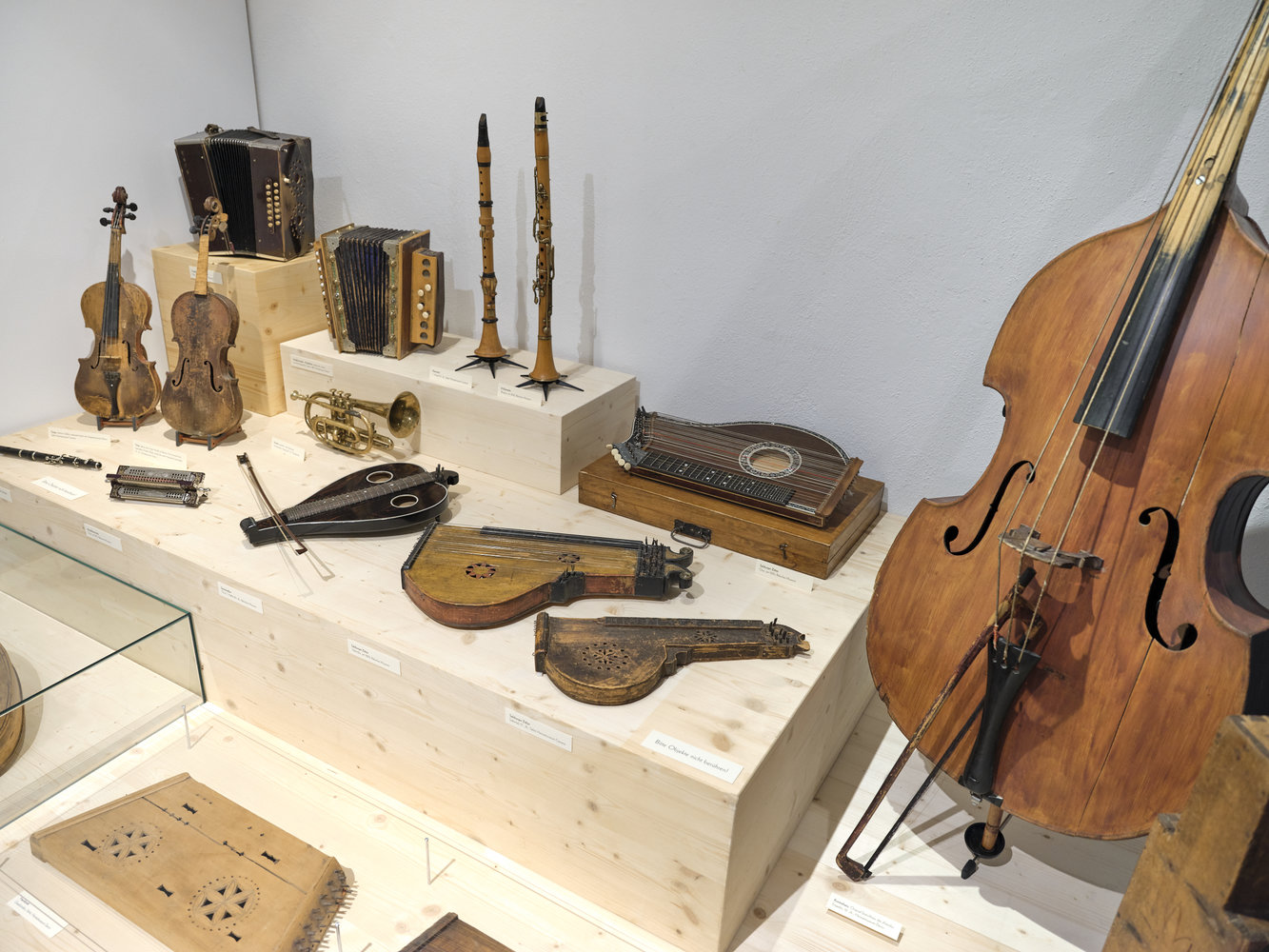
The exhibition at the Rhaetian Museum also highlights sounding specialties from Graubünden. While the tiba, a conical natural tone instrument made of wood or tinplate, was almost forgotten fifty years ago, this alphorn is making a comeback in the Surselva. It is being built, played as an amateur instrument and has led to a new use, the tibadas. The players line up in the landscape and respond in turn to a central tibada player.
In addition to cattle bells and goat horns, shepherd's music in the Münstertal included a signaling instrument that is unique in Switzerland, the Schüblöt da marmel. It is cut from gypsum stones that fall into the Rambach in Santa Maria Müstair. The little vessel flute, which lies completely on the tongue for playing, would have died out if a bright vacation boy from Alsace had not copied the way it was made and played from an old shepherd.
The violin schools in the Safiental can be counted among the special features of Graubünden's musical tradition. As early as the 19th century, several teachers taught schoolchildren how to make and play string instruments and brought together young people living far apart in scattered settlements to form music-making groups. Recently, the dance manuscripts from the Safiental have been edited and published.
Before the standardization of the Ländler band, dance ensembles made up of local string and wind players were formed in the villages of German-speaking Switzerland and named after the first name of the respective band leader. The Fränzlimusik, named after the legendary blind violinist Franz Waser, gave rise to the typical Engadin line-up of the Fränzlis da Tschlin (Red. see SMZ 11/2022, p. 19 f.).
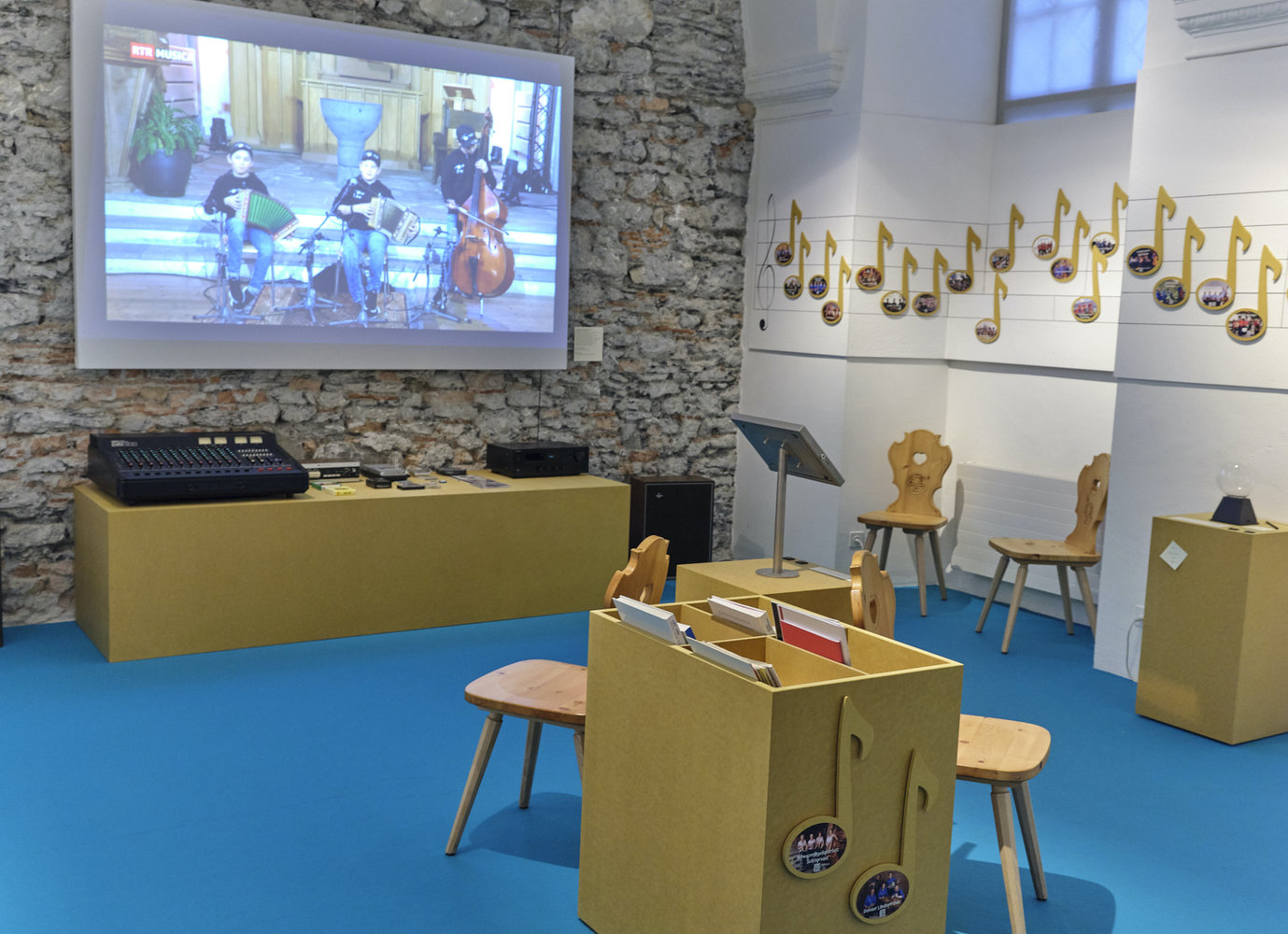
It was not until the 1930s that the instrumentation of the Ländlerkapelle was consolidated, in the so-called Bernese style (several Schwyzerörgeli and bass), the Central Swiss style (clarinet, Schwyzerörgeli, double bass and piano) and the Grisons style, depending on the major folk music regions, with two clarinets, two Schwyzerörgeli or accordion and bass. This "Ländler" style, first played by musicians from the Grisons in guest performances at Grisons clubs in the cities, later as members of Swiss-German bands, but above all through Radio Beromünster and records, became Swiss national music during the National Exhibition in 1939 and thus a spiritual national defense. This explains why the Bündner style is known and loved throughout Switzerland.
Boundlessly lüpfig. On the folk music of Graubünden. Special exhibition at the Rhaetian Museum (near St. Martin's Church) Chur, until March 3, 2024, Tue-Sun 10 a.m.-5 p.m.
Over twenty original works for violin and piano, from chicken to shark, from flea to elephant.
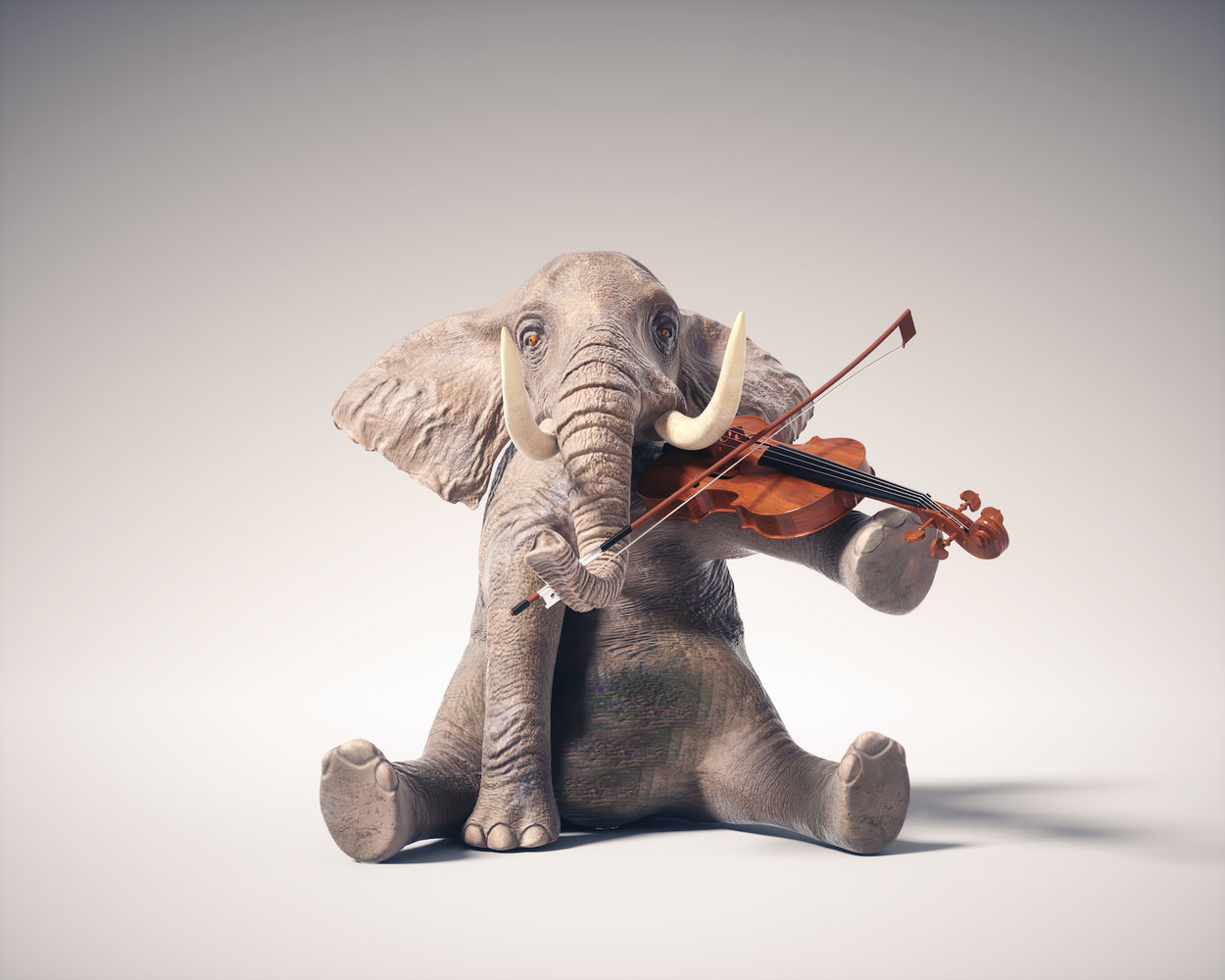
In addition to the seven famous animal pieces, you can discover 14 little-known works in this booklet. They are easy (1st to 3rd position) to moderately difficult (up to high positions) to play. The piano accompaniment is well chosen in the style of the respective originals (17th-20th century and South American); here and there the violin also takes over the accompaniment. The keys range between two B-flats and two sharps, a third of which are in a minor key. The booklet could be suitable for a class recital.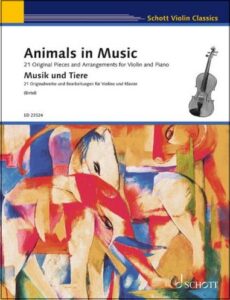
Animals in Music, 21 original works for violin and piano, arranged by Wolfgang Birtel with fingerings and bowings by Barbara Leichtweis-Birtel. ED 23524, € 19.50, Schott, Mainz
Adrian Wehlte turns an acoustic phenomenon into a listening and intonation course.
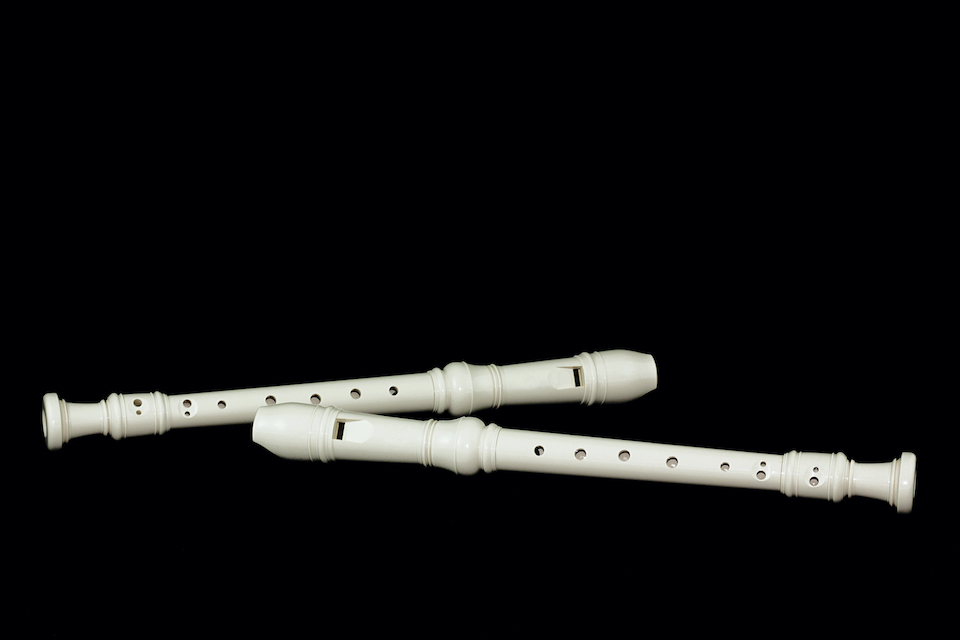
What's worse than a recorder? Two! - One of the things addressed in this joke is the fact that intonation on the recorder is difficult and complicated with two, because there is always something "buzzing, whirring, chirping or humming along", as it says in the preface to the Trios for two is called. One reason for this can be found in the specific overtone spectrum of the recorder. When two (especially high) recorders play together, at least one so-called combination tone is produced. While one usually simply tries to intonate the two recorders reasonably well together, Adrian Wehlte makes use of precisely this principle. His notated duos, when intoned completely pure, produce a combination tone that exactly matches the two notes played; the duo becomes a trio.
The booklet with a progressive level of difficulty is intended as a practical guide to intonation security by consciously perceiving combination notes. These are therefore notated in a further staff as a virtual third voice, which fits in with the two upper voices in terms of compositional technique and results in a real trio of two. When the duo is recorded, it becomes audible that the third voice not only exists as an acoustic phenomenon in the ears of the musicians, but is actually present in sound. Three of the duos present a puzzle in which the invisible third voice combination produces a familiar melody.
Explanations of the overtone series and the combination and difference tones round off the booklet; if you want to know more, you can go to forum.floeno.de or discuss this phenomenon on the discussion platform.
The Trios for two is available in an edition for two soprano recorders (oboes or clarinets) and for two alto recorders (transverse flutes), whereby the booklets contain the same exercises and original compositions.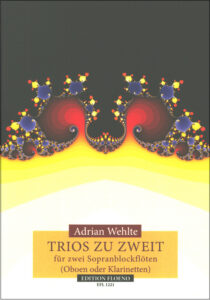
Adrian Wehlte: Trios zu zweit; Edition for 2 soprano recorders: EFL 1221; for 2 alto recorders or transverse flutes: EFL 1220; € 12.50 each; Edition Floeno, Dinkelsbühl